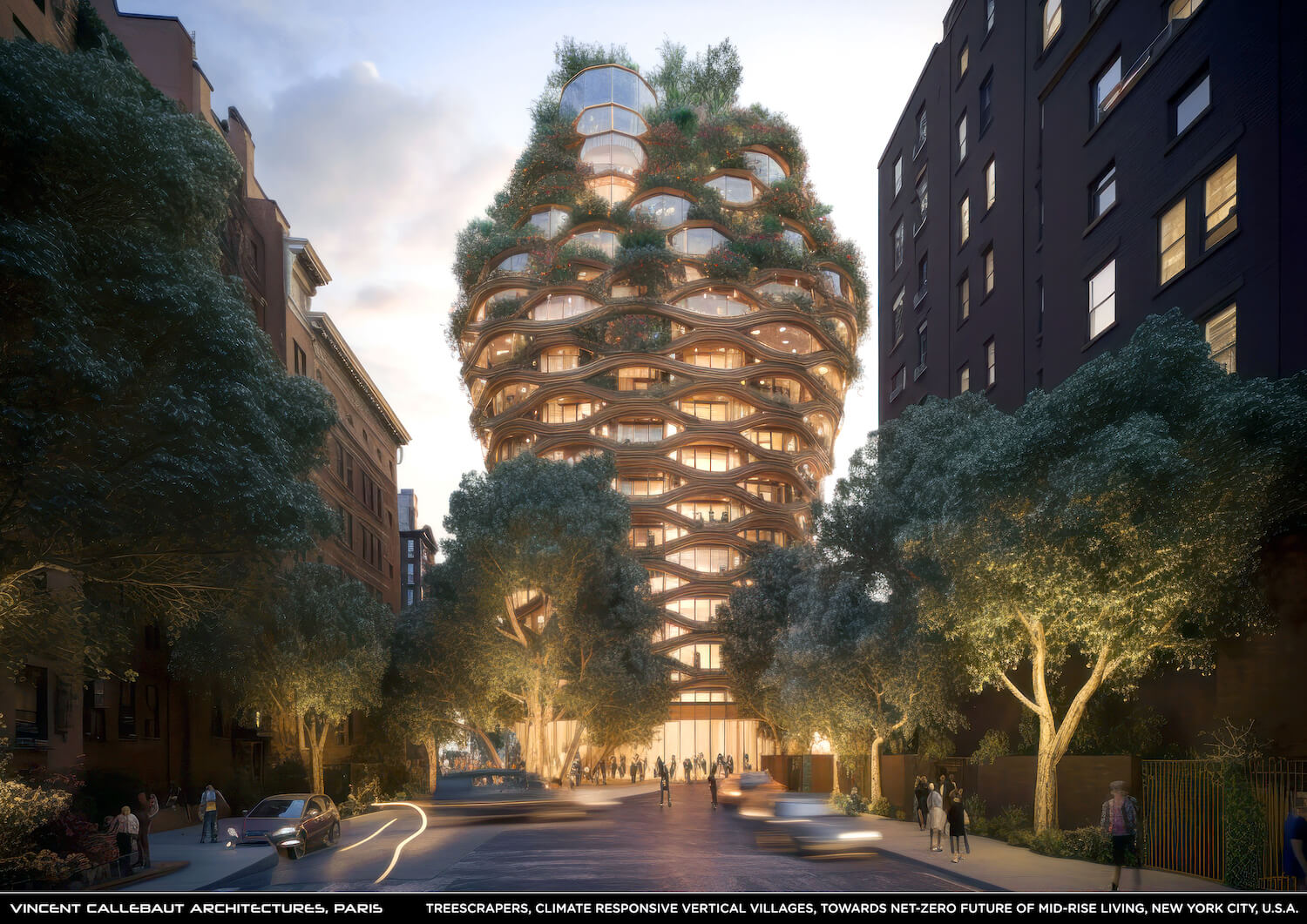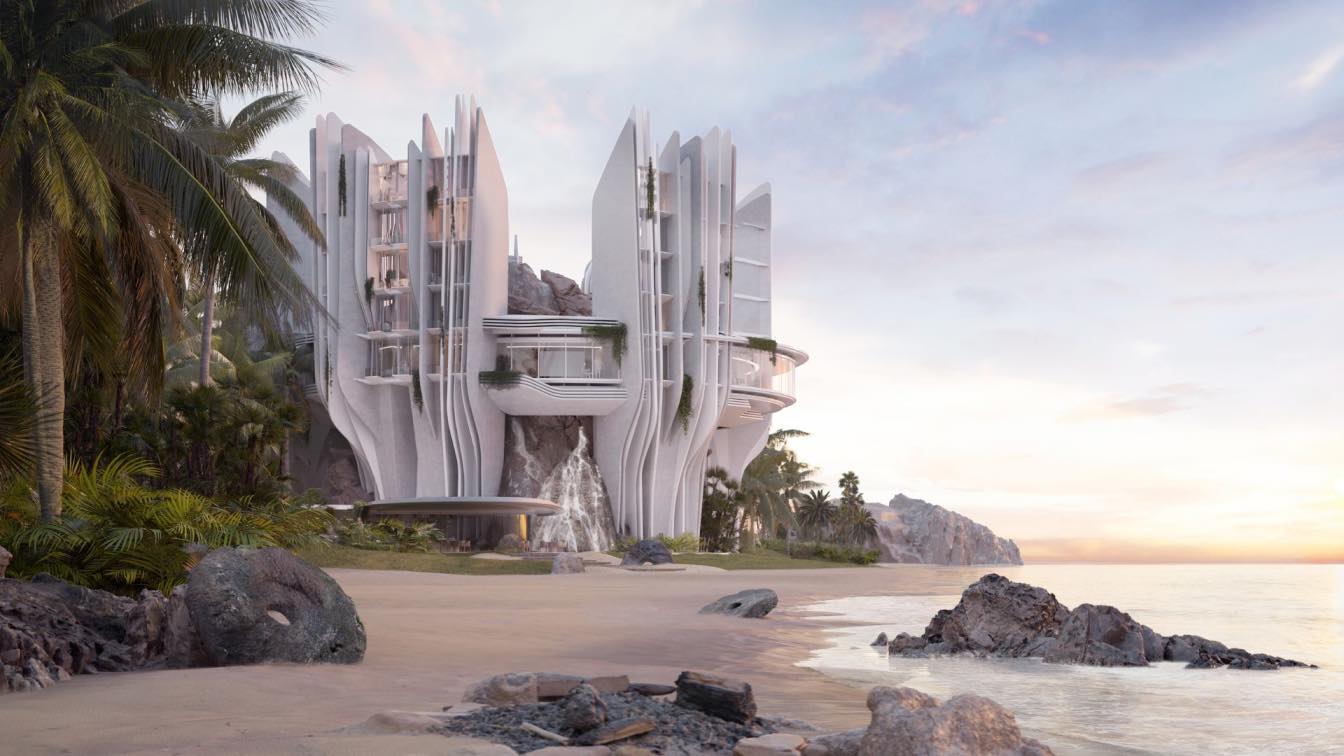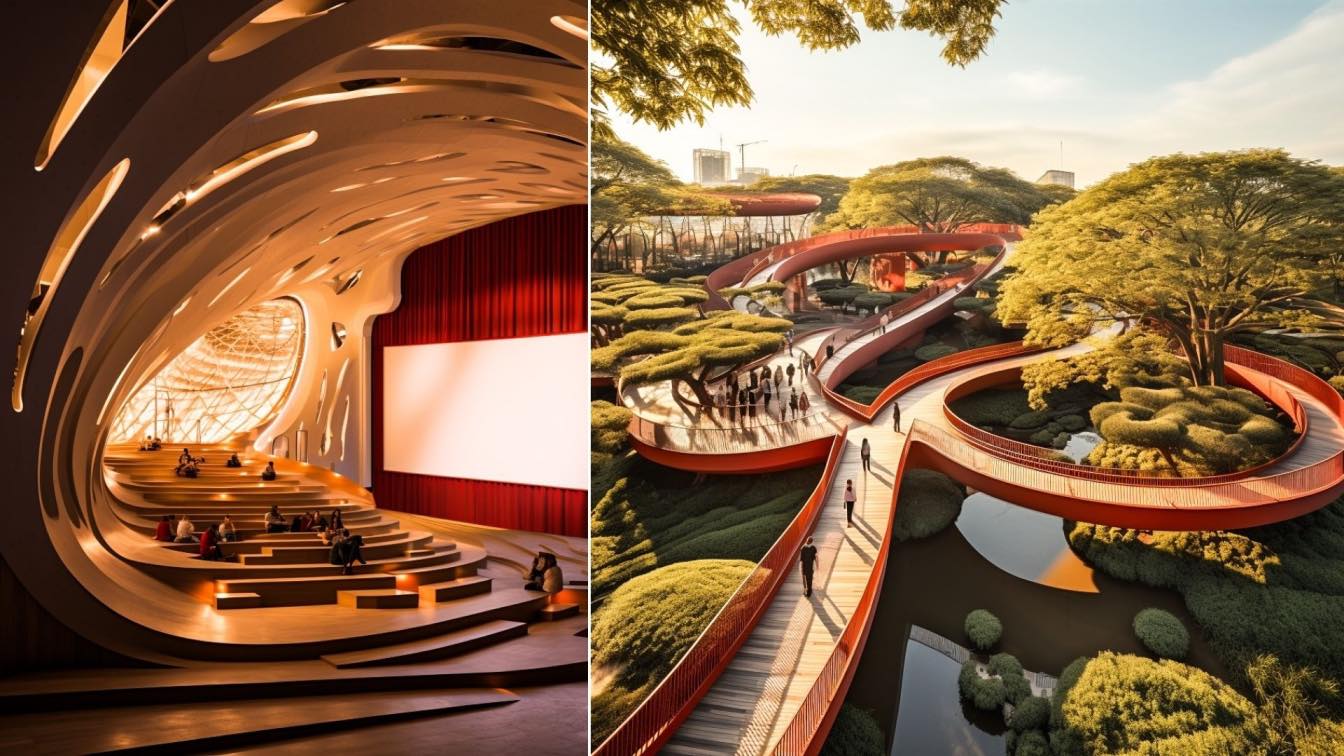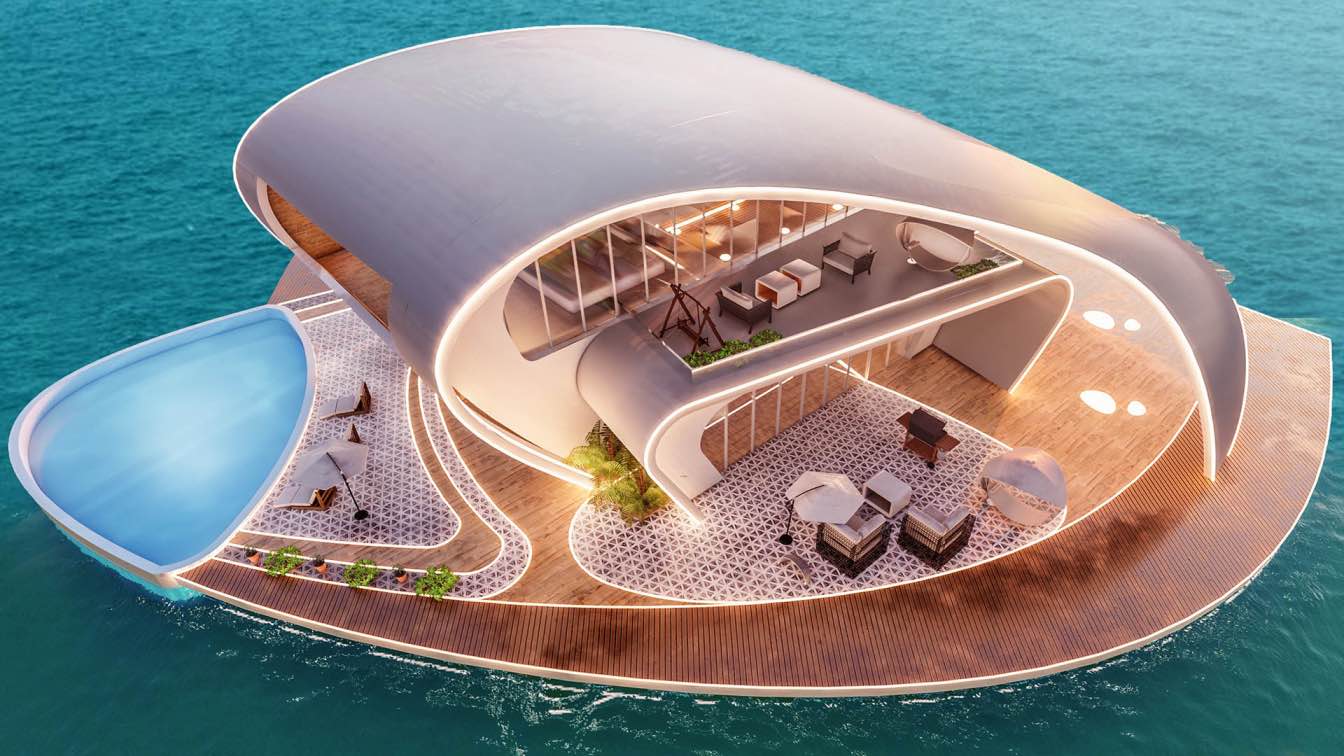Vincent Callebaut Architectures: Climate responsive vertical villages, towards net-zero future of mid-rise living, for a healthier, cleaner, cooler and sober New York City & United States Of America.
The "New York’s Green New Deal" provides for an 85% reduction in greenhouse gas emissions by 2050 compared to 1990. The remaining 15% could be offset by financing projects deemed beneficial for the climate. This ambitious agreement, also called the "Climate & Communities Protection Act", provides for 70% renewable energy by 2030 and a total elimination of emissions produced by electricity suppliers by 2040. It aims to promote a socially just transition. Thus, 35% of the State's energy budget should be directed to low-income and pollution-affected communities.
By merging Building Information Models (BIM) and artificial intelligence generative tools with new parametric climate simulation and construction process optimization software programs, our team of architects has conducted extensive research and development studies on the concept of "climate responsive village", requested to harmonize the construction of ecological buildings with the net-zero carbon objective of the "New York’s Green New Deal", from the Bronx to Brooklyn via Queens.

While individual suburban housing ensures space-consuming urban sprawl and Manhattan's concrete and steel skyscrapers are declared to be energy-intensive, the hybrid concept of the "climate responsive village", of medium size, merging low-carbon and biosourced materials , integrating the rules of bioclimatism, renewable energies, biodiversity and urban agriculture, presents an eco-responsible way of life which retains the advantages of saving space and land, while encouraging the development of short circuits and soft proximity mobility. It is an intelligent design of the city, called "people-centric", which gives eco-friendly buildings an increased sense of community and mutual aid.
Our professional commitment is to design increasingly successful sustainable development models in major cities like New York City to ensure the ecological transition of historic neighborhoods while maintaining the intrinsic qualities of the Genius Loci, creating a three-dimensional community based on diversity, flexibility and solidarity.
For a decade, parametric modeling of building data has had a considerable impact on the art of building “better with less”. It enables architects to make more informed decisions by creating more accurate and higher quality digital models throughout the life cycle of buildings, from design to construction, operation, and transformation.

Our goal is to explore, in the heart of New York City, construction and planning scenarios, to better integrate all design parameters and to analyze the carbon footprint of buildings on the environment with a view to improving their manufacturing processes. The digital models of the buildings thus help us in the analysis and the elaboration of the plurality of data and the best ecosystem options to take into account: for example, the technical characteristics of the materials, their carbon footprint, their local availability, their origins and their recyclability.
Finally, climate simulation tools now associated with artificial intelligence make it possible to optimize climate responsive design, which refers to architecture that integrates the meteorological, biological and geological conditions specific to the district where it is built. These new tools synthesize data on all that constitutes the local ecosystem such as the sun, the wind, the precipitation, the humidity, but also the endemic fauna and flora, and the organic and mineral composition of the soils to imagine the city of New York returning to resilience and symbiosis with Nature.

NEW YORK, A CITY-ECOSYSTEM ON THE TRACK OF RESILIENCE
To limit global warming to 1.5°C, in line with the 2015 Paris Agreement target, and thus maintain a habitable planet, emissions must be reduced by 45% by 2030 and to achieve the goal of net zero emissions by 2050. “Net zero emissions” means that greenhouse gas emissions must be reduced – on a global scale – to a level as close as possible to zero, the remaining emissions present in the atmosphere can be reabsorbed, by the oceans and the forests.
The transition to a carbon-neutral world is one of the greatest challenges that humanity has faced. It is quite simply a complete transformation of the way we produce, consume and travel.
“We need to turn all commitments to carbon neutrality into an unstoppable global movement.” proclaims António Guterres, General Secretary of the United Nations.
Alas, according to the scientific trajectories of 2023, greenhouse gas emissions are expected to increase by another 10% by 2030 compared to 2010 (instead of falling by 45%), based on the climate action plans of other states and nations which are globally insufficient to fight against climate change. This represents a moral bankruptcy for the capitalism in place which still must reinvent itself. According to the latest IPCC report, the policies currently in place lead us to a warming of 3.2°C in 2100, an unlivable world in many regions and for many species.
If we fail to reverse the trend, no territory will be spared by extreme weather events. In New York, already, urbanization exacerbates the effects of the heat wave on the population, its well-being, its health, with the multiplication of urban heat islands, the increase in water shortages, air pollution. The same goes during storms and hurricanes, when floods or torrential downpours descend in no time on impermeable soils unable to absorb the rains, causing more and more floods, sometimes destruction.

In fact, by concentrating populations, activities, wealth and infrastructure, a city like New York greatly contributes to climate change while suffering the consequences such as the rising waters that threaten its coastline. According to UN-Habitat, megacities account for 78% of global energy consumption and produce more than 60% of greenhouse gas emissions. Yet they make up less than 2% of the Earth's surface.
The exponential concentration of individuals in New York City leads us as urban planners and architects to rethink its infrastructures, its habitats, its mobility, the management of its waste in the sense of the preservation of resources and the respect of the environment. With two underlying trends: the vital fight against global warming through the renaturalization of the city on the one hand, and the desire of New Yorkers to reclaim and share urban space on the other, all in the perspective of well-being and good living, consequences of the confinements experienced during the health crisis.
Starting from the founding idea that the environment in the broad sense contributes to the reduction of stress in urban areas, to a more positive overall state of mind (physical and mental), and therefore to the increase in well-being and quality of life, our biophilic approach is based on bringing the individual and architecture closer to nature and endemic biodiversity.
Thus, at the same time as the city of New York continues to densify, its green and blue fabric unfolds three-dimensionally. The floors, balconies, facades, and roofs of the neighborhoods are becoming greener, the last industrial wastelands are becoming gardens, the "green corridors" irrigate the urban space. Vertical farms are springing up to supply city dwellers and reduce the energy cost of transporting agricultural commodities. Everything is redesigned with the aim of increasing the city's ability to capture CO2 and rainwater to reduce the urban heat island effect.

In addition to the fight against floods and the planting of 1 million trees, to achieve the objectives of carbon neutrality by 2050, the world of construction in New York must meet several major challenges, including the thermal renovation of existing buildings and the construction of structures with low energy consumption and net-zero greenhouse gas emissions.
To achieve this, Biomimicry is an emergent, creative, and interdisciplinary process, between biology and technology, between science and architecture, whose goal is to solve our anthropocentric problems and the resulting climate change through the transfer and the application of knowledge resulting from the observation of biological models in order to develop constructive processes and spatial organizations allowing the sustainable development of our societies.
Our leitmotif is to transform New York City into an ecosystem, its neighborhoods into forests and its buildings into inhabited trees producing their own energy and recycling all their waste into resources.
Nature only uses photosynthesis as its sole source of energy. Nature produces no pollution and no waste that cannot be recycled. Nature always relies on cooperation between species and limits excesses from outside. Our New York architectures want to do the same!
The DNA of our architecture is based on the greening of buildings, the benefits of which are no longer to be proven: the fight against urban heat islands, the fight against atmospheric pollution, the fight against soil sealing, rainwater management, recycling of gray water, reinforcement of green and blue urban networks, protection of biodiversity, implementation of urban well-being, solidarity development of Urban Agriculture.

NEW YORK, NEIGHBORHOODS ON THE WAY TO SOBRIETY
Sobriety in energy, raw materials, upkeep, and maintenance induces the hybridization of low-tech and high-tech approaches. Low-tech means for us to build better with less! This is our line of conduct in both production and design. Sobriety requires innovation, creativity and above all collective intelligence to imagine the New York of 2050.
First of all, our eco-design strategy is based on four major pillars:
1. COMPLIANCE WITH CLIMATE RESPONSIVE DESIGN: This involves sculpting the buildings based on the climatic data of the place such as the course of the sun from East to West and the direction of the prevailing winds to limit the venturi effects, optimize natural ventilation, and orient stays as best as possible to benefit from the best solar gain. The design of the facades, terraces and through apartments is thus thought out to be as energy efficient as possible, with the minimum of mechanical air conditioning to tend towards a passive architecture integrating natural ventilation systems such as wind chimneys.
2. INTEGRATION OF RENEWABLE ENERGIES: To move towards a BEPOS (Positive Energy Building), the integration of renewable energies (axial wind turbines, solar panels, geothermal energy) makes it possible to produce self-consumption of the cooling, heating and electrical energy whose buildings need to aim for carbon neutrality.
3. SPATIAL AGILITY: In the circular economy, the best waste is the one that is not created! The durability and mutability of the habitat lies first and foremost in its ability to adapt to changing uses and ways of living. It is the meaning of history to consider as far as possible from its design the possible future scenarios of the life of the buildings. Habitats that can be transformed at will and hyper-flexible which must be able to marry the constant evolutions of the intergenerational family unit on the one hand and the necessary mutability between our spaces of private life and professional life on the other hand.
4. URBAN AGRICULTURE: On the roofs of buildings and in the heart of the plots, we imagine integrating greenhouses and market gardening orchards cultivated in permaculture and dedicated to urban agriculture to strengthen solidarity and social cohesion at the scale of residents and neighbors.

At the same time, we are working on 3 major targets to make New York City more sober:
1. ENERGY EFFICIENCY: At the scale of the building, we want to build through and/or multi-oriented housing that is healthy and pleasant to live in with a low rate of mechanical ventilation and without air conditioning, or even without heating. Thanks to natural ventilation, passive cooling, recovery of free heat input and thermal inertia, the climate responsive design makes it possible to reduce energy consumption to a strict minimum, while ensuring increased comfort.
2. NATURAL MATERIALS: Biobased, geo-sourced or reused materials are favored both for the structure of the building and for its insulation or façade claddings. They are carefully selected to highlight the local ecosystem and short circuits. Cross-laminated wood, engineered wood or bamboo, wood wool, straw, hemp concrete, low-carbon concrete, earth concrete, raw earth and terracotta, all these natural materials fit into our so-called regenerative circular economy approach, where all waste becomes a resource.
3. TECHNICAL SOBRIETY: Sobriety does not mean an absence of technology, but the priority use of relevant, appropriate, non-polluting, or wasteful techniques, such as simple implementations and devices that are easy to repair, recycle and to reuse. As William Shakespeare said so well: “the intelligence of a city lies first and foremost in that of its inhabitants”. Technology is there to implement the building by optimizing, for example, our energy consumption or the intelligent sharing of convivial places.
Putting the right energy and the right material in the right place above all means building low carbon and, in fact, using renewable energies and biobased materials produced locally in short circuits to the detriment of all others.
In addition to the development of bio-concrete and low-carbon steel, massive timber is enjoying a spectacular renaissance around the world as a renewable raw material and the oldest building material in history. In terms of decarbonization, wood construction can play a big role in CO2 sequestration, but if we want to face our impact on climate change, we need a diversified pool of resources to be able to choose among several low-carbon options and apply them. Thus, biosourced materials, with wood in mind, straw, hemp concrete, bamboo, and geosourced materials, such as biobased raw earth and dry stone, are gaining visibility in New York City.
The low-carbon and bio-based construction industry must give priority to improving understanding of the entire life cycle of materials, from design to dismantling of buildings, to encourage their reuse in new configurations, like a giant meccano.

NEW YORK, REGENERATIVE BUILDINGS ON THE WAY TO CIRCULARITY
At the heart of the challenges of the New York City of tomorrow, the problem of resources (which are not unlimited) and that of waste make up the virtuous circle of the circular economy. The circular economy - known as regenerative - is the economic model which aims to move from an all-disposable society, based on a linear economy (extract, manufacture, consume, throw away) towards a more circular economic model which recycles everything to avoid waste. depletion of the planet's resources.
In other words, we must learn to consume with sobriety, improve sustainability, limit waste and turn our waste into new resources. The objective of this regenerative architecture is to massively deploy renewable energies and to create spaces that meet the primary needs of occupants, easily adaptable, while minimizing costs, waste and environmental impact.
To build sustainably and with common sense is to stop destroying and, even, to know how not to build, but to regenerate, metamorphose, reconvert, rehabilitate, renovate, enlarge, and give new life to the “already there”.
Sustainable building therefore means developing a New York urbanism that is favorable to health (improving air quality, noise reduction, presence of nature in the city, opportunities for active travel), it means promoting energy sobriety , reduce greenhouse gas emissions, sequester carbon, move towards a circular economy, promote natural spaces and biodiversity (urban cooling, city permeability, food resilience) including in the recovery of degraded land.
Sober but creative, our biomimetic and regenerative architectures wish to stimulate happiness, the joy of living among New York residents. They draw their inspiration from the Genius Loci, the culture of its places, its air, its soil, its biodiversity, and the economy of its territory. Their ambition is to become the emblem of the correct symbiosis of the Humanity-Nature couple at the heart of the Big Apple.



















































